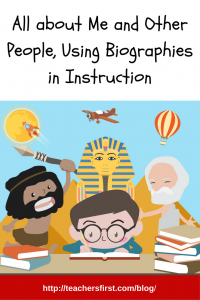 The start of the school years is a time to get to know our students. Perennial favorite activities other than “what I did on my summer vacation” essays are “all about me” assignments.
The start of the school years is a time to get to know our students. Perennial favorite activities other than “what I did on my summer vacation” essays are “all about me” assignments.
As students take a look at their own lives, this is a perfect time to add biographies to your class lessons. Reading about famous lives fits into just about any content area. Of course, English language arts is a given; but reading about famous people in history, the sciences and technology can be enriching and inspiring at all grade levels.
When I did biography booktalks for my students, I loved to use this analogy to help them remember the difference between a biography and an autobiography. I would remind them of Latin root words. “Bio” equals life and “graphy” means writing, so a biography is a book that someone writes about someone else. An autobiography begins with the root “auto,” meaning self; so an autobiography is a life story one writes about oneself, just like a person drives an “automobile” by oneself. Students still would get bibliography and biography confused, so I shared those Latin roots in their annotated bibliography assignment. (Hint: “biblio” means book.)
Those teachers in states using standards modeled after the Common Core are familiar with students in grades K-5 reading a range of informational text, defined in the standards to include “biographies and autobiographies, books about history, social studies, science, and the arts.” While grades 6-12, “Literary Nonfiction and Historical, Scientific, and Technical texts includes the subgenres of exposition, argument, and functional text in the form of personal essays, speeches, opinion pieces, essays about art or literature, biographies, memoirs, journalism.”
When students at my school read Salinger’s Catcher in the Rye, an English teacher and I co-taught a project to research a person who challenged the system. Fifteen years ago it was cutting edge to look for supporting resources both in print and online and then create a slide presentation that demonstrated what the person believed in and how they fought against the status quo. Teaching PowerPoint seemed innovative, and the kids couldn’t get enough of inserting pictures and playing with formatting. Now, a myriad of tech tools can easily be used to prepare and present multimedia presentations for a similar-type assignment. Here are some resources for using biographies in instruction.
Resources about Biographies
- When selecting biographies, try the Diverse Bookfinder from Bates College. The current list includes these biographies. This tool is in response to a major discussion about children and young adult literature, the lack of diversity in publishing. See the survey from the Cooperative Children’s Book Center and 2015 infographic where 73% of books published were about white main characters and the statement from the American Library Association Division Association for Library Service to Children on the Importance of diversity in library programs and material collections for children.
- Association for Library Service to Children Best Websites for Kids, Biographies
- Delightful Children’s Books 30 Picture Books Biographies can be used at all levels.
- Mr. Nussbaum Biographies for Kids
- The Best Children’s Books, Biographies for Kids
Lesson Plans and Activities Using Biographies
- TeachersFirst has reviewed over sixty different websites and interactive tools on creating presentations that students can use for biography projects to avoid encyclopedia-style reports.
- ReadWriteThink from the National Council of Teachers of English offers 80 plus lesson plans using biographies, but try these cool interactives that can be used in many different ways in the classroom.
- The BioCube is an interactive to input biographical information.
- The StaplesLess Book is an interactive for almost any grade level that creates a booklet online that can be printed out.
- The Interactive Timeline is an interactive tool to create with lesson plan of creating an autobiography timeline.
- Ms. Jordan Reads Blog Tech Tools for Biography Projects .
- DigitalWish Biography Lesson Plans K-12 teaches about biographies using technology.
- Education World offers many ideas on using biographies.
- Biography Brainstorm Middle School lesson plan can be adapted for any grade.
- Ten Ways To Teach Biographies for any grade level.
- Building Biographies: Bringing Real-Life Stories Into Your Curriculum.
- Great Sites for Teaching About Biographies.
- iRubric: Famous Person Poster Project but use tech tools to make an online poster.
- Scholastic Introducing Biography Genre Introducing Biography Genre and Getting to Know You lesson with graphic organizer.
- Scholastic Simple Rubric can be adapted for almost any biography project.
- BrainPOP Biography Activities K-5.
- Creative Educator Video Biography project.
- Using Biography in the History Classroom lesson plan.

